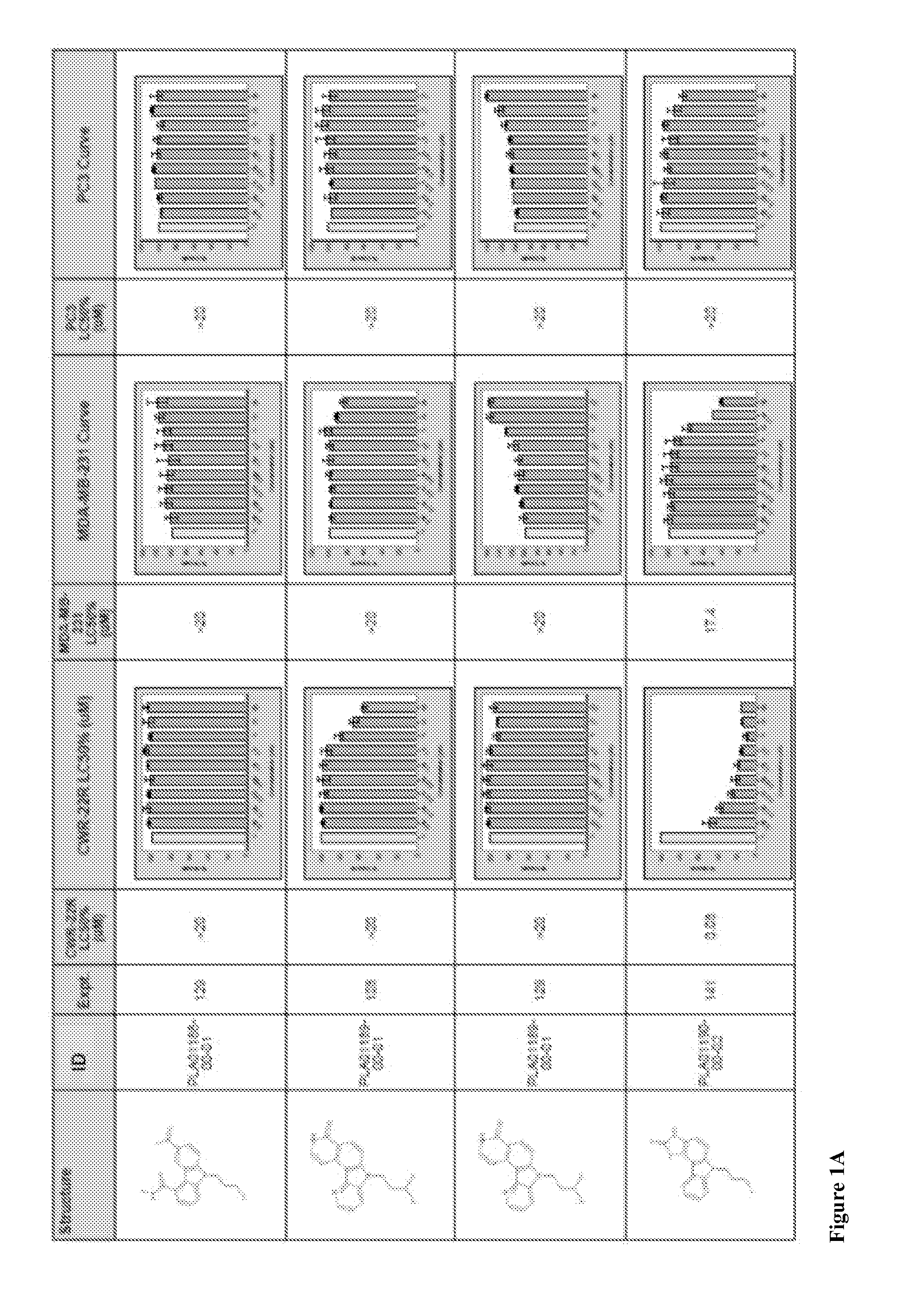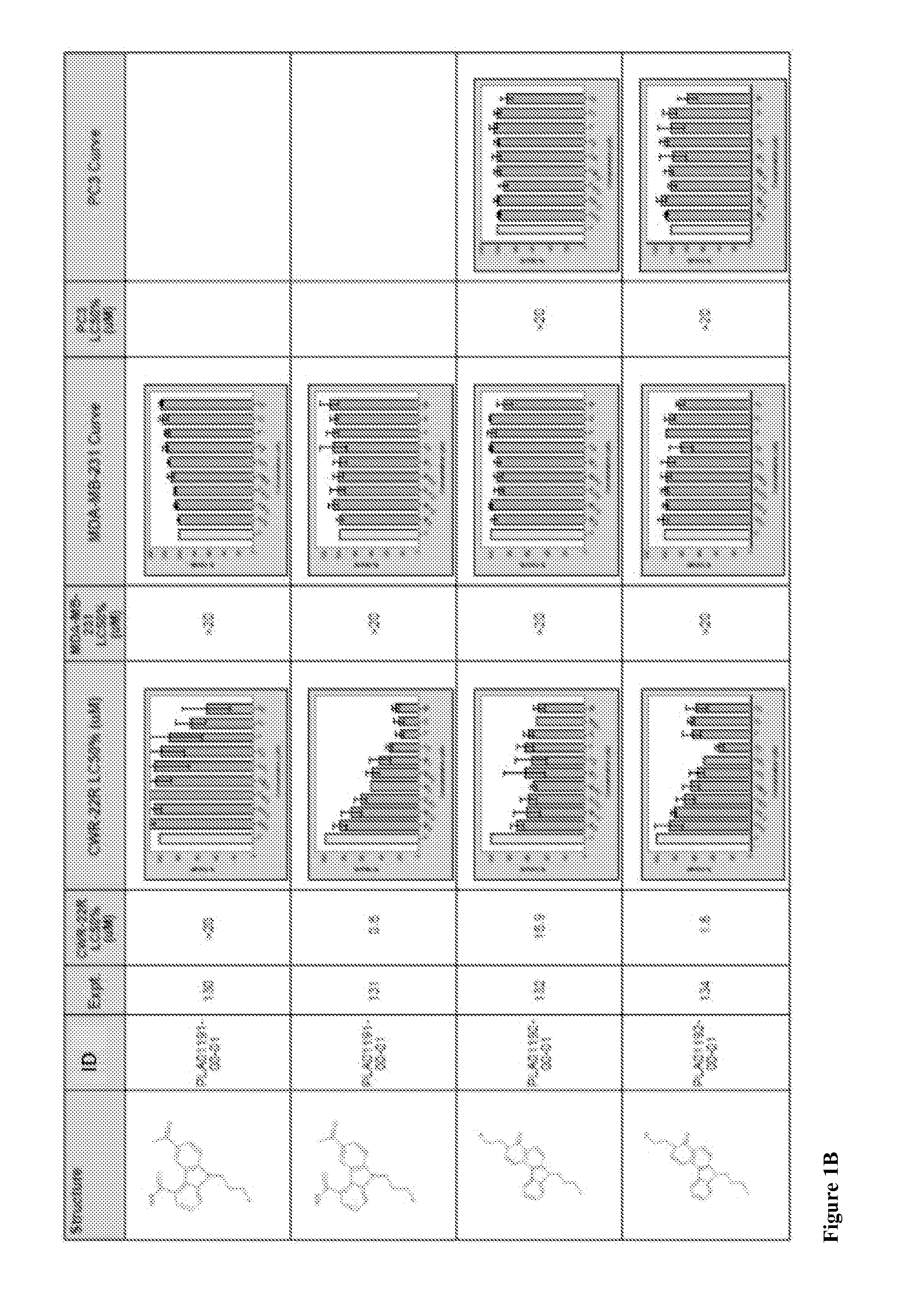Compounds and methods for treating cancers
a technology of carbazole and compound, applied in the field of carbazolelike compounds, can solve the problems of complete cure, androgen-dependent, chemotherapy-resistant tumors with poor prognosis, and resistance to anti-androgen therapy, and achieve the effect of improving the survival rate of patients and improving the survival ra
- Summary
- Abstract
- Description
- Claims
- Application Information
AI Technical Summary
Benefits of technology
Problems solved by technology
Method used
Image
Examples
example 1
Compound 1-1. 6-Propyl-1,2-dihydro-6H-cyclopenta[c]carbazol-3-one
[0130]
[0131]Step 1. Compound 1a-1. 4-(2-Nitrophenyl)-indan-1-one. A biphasic mixture of 4-bromo-1-indanone (2.0 g, 9.48 mmol), 2-nitrophenylboronic acid (3.16 g, 9.48 mmol), dichloro[1,1′-bis(diphenylphosphino)ferrocene]palladium(II) (348 mg, 0.47 mmol) and potassium carbonate (2.62 g, 9.48 mmol) in 1,4-dioxane:water (4:1, 18 mL) was heated at 120° C. for 30 min under microwave irradiation. The mixture was evaporated and the residue was diluted with water (50 mL) and extracted with dichloromethane (3×50 mL). The combined organic layers were dried over sodium sulfate and evaporated. The residue was purified by column chromatography eluting with hexane:ethyl acetate (100:0→60:40) to give the title compound (1.97 g, 7.78 mmol, 82%) as a yellow crystalline solid. LCMS: 88%, Rt 1.491, ESMS m / z 254 (M+H)+.
[0132]Compounds 1a-2—1a-8 shown in the table below were prepared in a similar manner using the appropriate aryl bromide.
A...
example 2
Compound 2-1. 7-Propyl-2,3-dihydro-1H,7H-pyrido[3,4-c]carbazol-4-one
[0137]
[0138]To a mixture of 6-propyl-1,2-dihydro-6H-cyclopenta[c]carbazol-3-one (Compound 1-1, 210 mg, 0.80 mmol) and methanesulfonic acid (850 μL, 13.1 mmol) in dichloromethane (8 mL) was added sodium azide (103 mg, 1.60 mmol) and the mixture stirred at 0° C. for 1 h. The reaction mixture was poured into 20% aqueous sodium hydroxide (30 mL) and extracted with dichloromethane (3×30 mL). The combined organic layers were dried over sodium sulfate and evaporated to give the title compound (207 mg, 0.74 mmol, 93%) as a tan solid. LCMS: 84%, Rt 1.611, ESMS m / z 279 (M+H)+. The product was used in the next step without further purification. 1H NMR (500 MHz, CDCl3) δ ppm 8.27 (d, J=8.8 Hz , 1H), 8.17 (d, J=7.8 Hz , 1H), 7.45-7.55 (m, 2H), 7.40 (d, J=8.8 Hz , 1H), 7.30 (t, J=7.3 Hz , 1H), 5.97 (br. s., 1H), 4.32 (t, J=7.1 Hz , 2H), 3.73-3.80 (m, 2H), 3.66 (t, J=6.6 Hz , 2H), 1.94 (sext, J=7.4 Hz, 2H), 1.00 (t, J=7.4 Hz, 3H)....
example 3
Compound 3-1. 7-Propyl-3H,7H-pyrido[3,4-c]carbazol-4-one
[0140]
[0141]A mixture of 7-propyl-2,3-dihydro-1H,7H-pyrido[3,4-c]carbazol-4-one (Compound 2-1, 170 mg, 0.61 mmol) and 2,3-dicyano-5,6-dichloro-1,4-benzoquinone (277 mg, 1.22 mmol) in 1,4-dioxane (2.5 mL) was stirred at 100° C. for 14 h. The reaction mixture was evaporated and the residue was taken up in dichloromethane (10 mL) and washed with 10% aqueous sodium hydroxide (2×10 mL). The organic layer was dried over sodium sulfate, evaporated and purified by column chromatography eluting with dichloromethane:methanol (99:1→95:5) to give the title compound (41 mg, 0.15 mmol, 24%) as an off-white solid. LCMS: 98%, Rt 1.598, ESMS m / z 277 (M+H)+; 1H NMR (500 MHz, DMSO-d6) δ ppm 11.26 (br. s, 1H), 8.46 (d, J=7.8 Hz, 1H), 8.30 (d, J=8.8 Hz, 1H), 7.80 (d, J=8.8 Hz, 1H), 7.77 (d, J=8.3 Hz, 1H), 7.48-7.55 (m, 1H), 7.36-7.44 (m, 2H), 7.31-7.36 (m, 1H), 4.49 (t, J=7.1 Hz, 2H), 1.83 (sext, J=7.3 Hz, 2H), 0.89 (t, J=7.3 Hz, 3H).
[0142]Compound...
PUM
 Login to View More
Login to View More Abstract
Description
Claims
Application Information
 Login to View More
Login to View More - R&D
- Intellectual Property
- Life Sciences
- Materials
- Tech Scout
- Unparalleled Data Quality
- Higher Quality Content
- 60% Fewer Hallucinations
Browse by: Latest US Patents, China's latest patents, Technical Efficacy Thesaurus, Application Domain, Technology Topic, Popular Technical Reports.
© 2025 PatSnap. All rights reserved.Legal|Privacy policy|Modern Slavery Act Transparency Statement|Sitemap|About US| Contact US: help@patsnap.com



